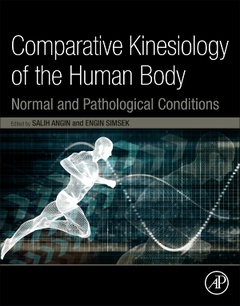Comparative Kinesiology of the Human Body Normal and Pathological Conditions
Coordonnateurs : Angin Salih, Simsek Ibrahim

Comparative Kinesiology of the Human Body: Normal and Pathological Conditions covers changes in musculoskeletal, neurological and cardiopulmonary systems that, when combined, are the three pillars of human movement. It examines the causes, processes, consequences and contexts of physical activity from different perspectives and life stages, from early childhood to the elderly. The book explains how purposeful movement of the human body is affected by pathological conditions related to any of these major systems. Coverage also includes external and internal factors that affect human growth patterns and development throughout the lifespan (embryo, child, adult and geriatrics).
This book is the perfect reference for researchers in kinesiology, but it is also ideal for clinicians and students involved in rehabilitation practice.
PART 1: HISTORY AND BASICS OF KINESIOLOGY 1. Past, Present and Future of Kinesiology 2. Principles of Kinesiology 3. Fundamentals of Human movement, Its Control and Energetics 4. Architecture of Human Joints and their Movement
PART 2: TISSUES 5. Morphogenesis and Biomechanics of the Embryo and Foetus 6. Architecture of Bone Tissue and its Adaptation to Pathological Conditions 7. Architecture of Cartilage Tissue and its Adaptation to Pathological Conditions 8. Architecture of Muscle Tissue and its Adaptation to Pathological Conditions 9. Architecture of Tendon and Ligament and their Adaptation to Pathological Conditions 10. Architecture of Fascia and its Adaptation to Pathological Conditions
PART 3: UPPER EXTREMITY 11. Kinesiology of the Shoulder Complex 12. Kinesiology of the Elbow Complex 13. Kinesiology of the Wrist and Hand
PART 4: TRUNK AND PELVIS 14. Kinesiology of the Temporomandibular Joint 15. Kinesiology of the Cervical Vertebral column 16. Kinesiology of the Thoracic Vertebral Column 17. Kinesiology of the Lumbar Vertebral Column 18. Kinesiology of the Pelvis
PART 5: CARDIORESPIRATORY SYSTEM 19. Kinesiology of Respiration 20. Biomechanics of Circulation
PART 6: LOWER EXTREMITY 21. Kinesiology of the Hip 22. Kinesiology of the Knee 23. Kinesiology of the Ankle and Foot Complex
PART 7: SENSORY-MOTOR INTEGRATION AND PERFORMANCE 24. Motor Control and Sensory-Motor Integration of Human Movement 25. Motor Learning 26. Balance and Postural Control
PART 8: LOCOMOTION 27. Effect of Weightlessness on Human Body 28. Evolution of Bipedalism 29. Kinesiology of Human Gait 30. Biomechanical Principles of the Exercise Design
Researchers of kinesiology as well as clinicians and students involved in rehabilitation practice; this may include exercise physiologists, physical therapists, occupational therapists, prosthetics and orthotics specialists, podiatric specialists, athletic trainers, and sports medicine physicians. Secondary: Biomedical engineers who design equipment for transportation, rehabilitation clinics and aiding daily living activities.
Dr. Ibrahim Engin Simsek is an associate professor at Dokuz Eylül University, School of Physical Therapy. Lecturer in kinesiology, prosthetics and orthotics. His main areas of interest include human movement and kinesiology, orthotic appliances, Cad-cam manufacturing in orthotics and prosthetics. His most recent research has been dedicated to postural control and vertical perception in adolescent idiopathic scoliosis, kinematics and kinetics of falling in humans, and postural control in hypermobility syndromes. Dr. Simsek serves as editor for two industry journals
- Includes in-depth coverage of the mechanical behavior of the embryo as one of the major determinants of human movement throughout the lifecycle
- Provides a comparison of human movement between normal and pathological conditions
- Addresses each body region in functional and dysfunctional kinesiological terms
Date de parution : 03-2020
Ouvrage de 576 p.
21.4x27.6 cm
Mots-clés :
Movement; motion; muscles; physiology; biomechanics; gait; exercise; morphogenesis; cartilage; tendon; ligament; fascia; joints; circulation



